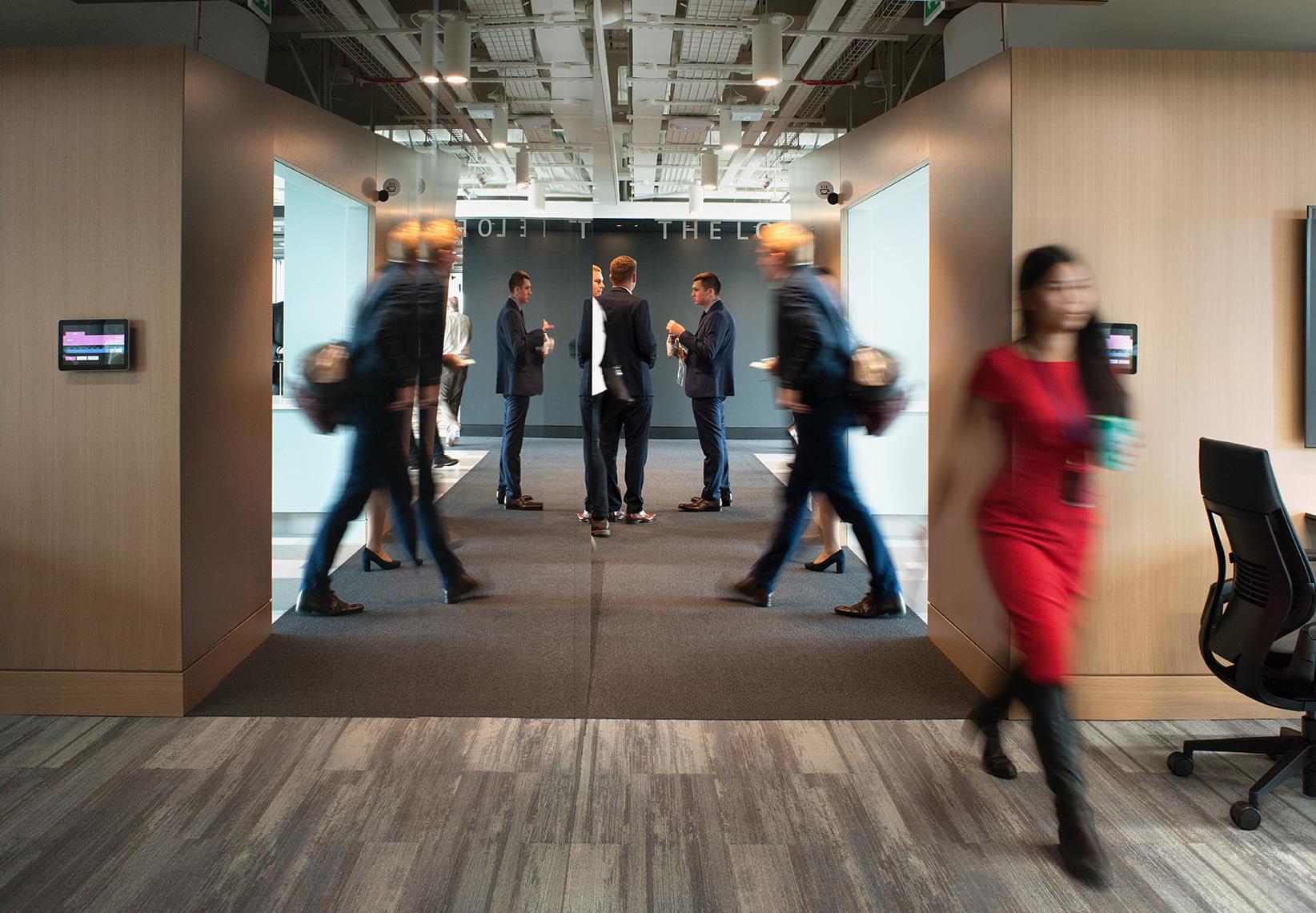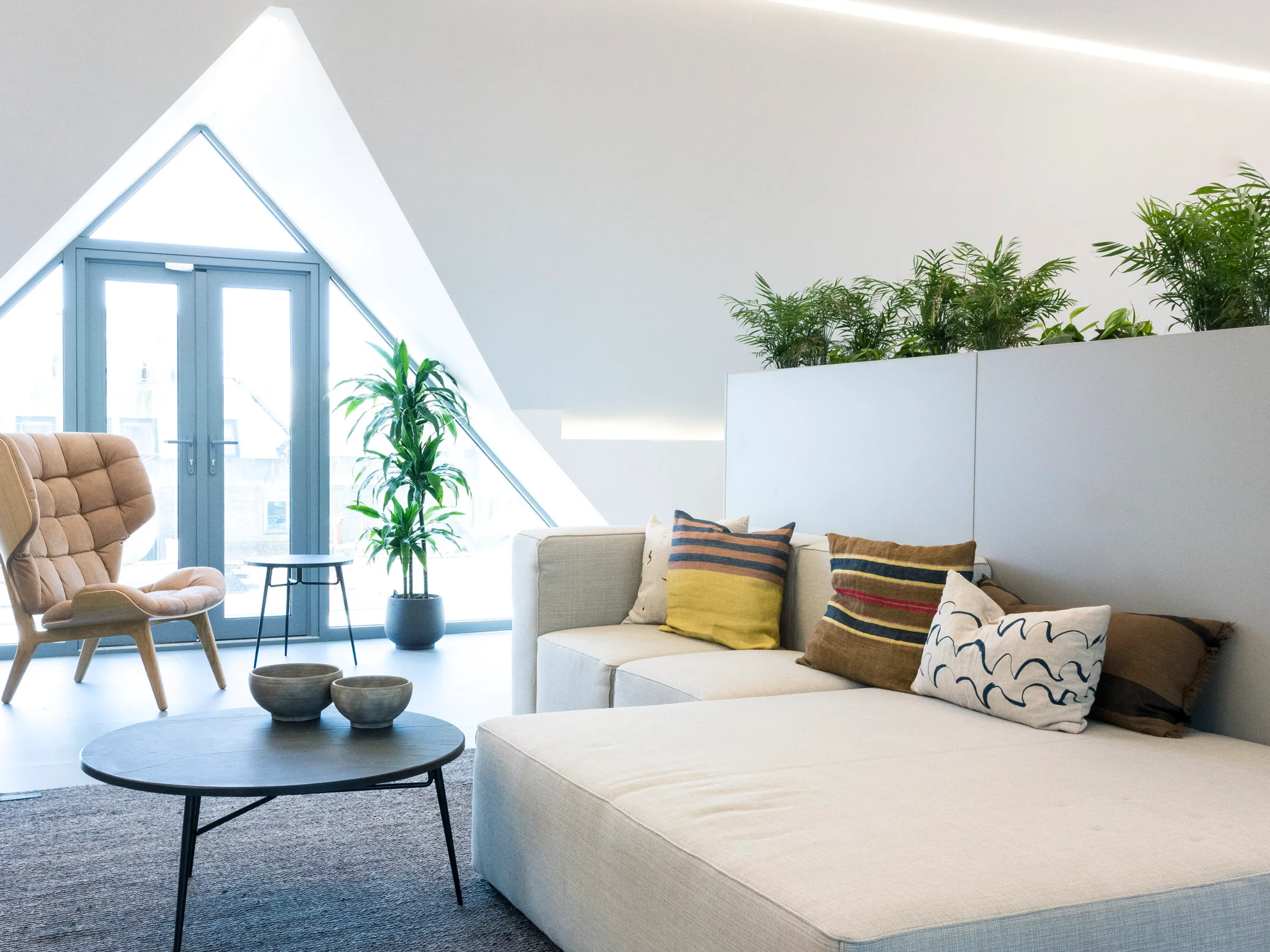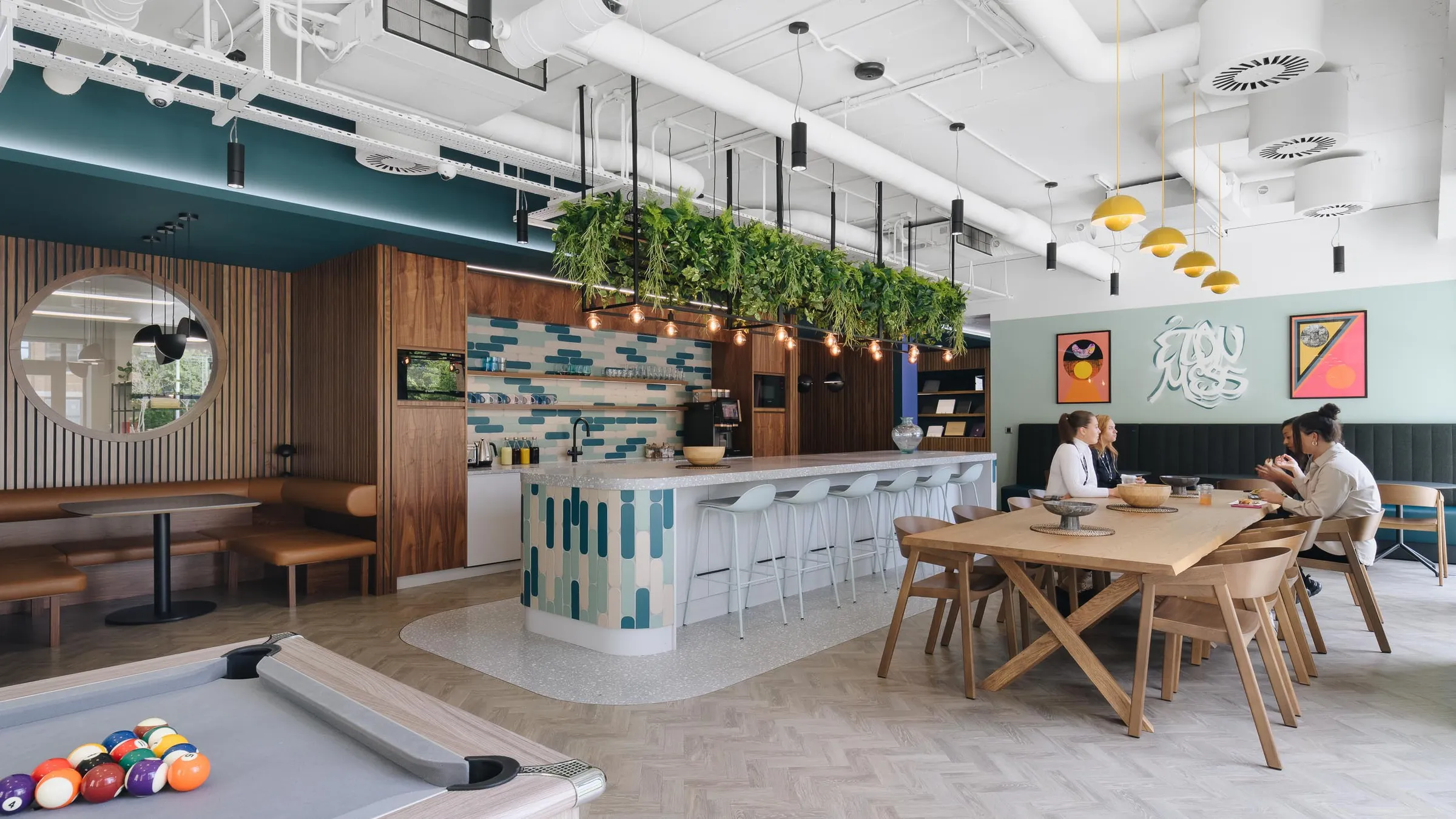The Impact of Workplace Design on Productivity
Office design, when done well, is psychologically driven to enhance the productivity of those who use the space. In this article, we’ll round up some eye-opening statistics on the impact of workplace design on productivity.


Written by
Fritha Selwyn Jones
Contents
We spend one-third of our life at work. That’s a lot of time when you think we also spend one-third of our life asleep too. With workplace wellbeing having such a significant impact on our overall mental and physical health, it’s vital that the workplace we spend time in is made to support our minds and bodies.
UK productivity in the workplace is dwindling. Between 1974 and 2008, workplace productivity grew by 2.3%, but from 2008 and 2020, that rate was just 0.5%. What’s going wrong?
When we have positive feelings about the space in which we work, this has a knock-on effect on essentials like productivity, creativity, and work ethic. Office design, when done well, is psychologically driven (among other drivers like sustainability and ergonomics) to enhance the productivity of those who use the space. We know this well because we help our clients improve their team productivity with office design every day.
In this article, we’ll round up some eye-opening statistics on the impact of workplace design on productivity.
The Impact of Bad Office Design on Productivity
Gensler conducted a survey in 2005 on how poorly designed offices erode productivity and estimated that poorly designed office spaces could be costing UK businesses up to £135 billion a year. Individuals in this survey reported they would be 19% more productive in a better working environment.
4 in 5 of the professionals in the survey felt their job satisfaction was significantly attributed to the quality of their working environment. Unfortunately, the majority felt their office had not been designed to support their job function.
Productivity is directly related to any employee’s satisfaction, as this positive mindset about the purpose of their work, their work ethic, and their sense of self-worth in the job produce better results. In the Gensler survey, 19% said they would be embarrassed to show their work environment to a customer, 38% believed it was difficult to be creative in their office, and 78% said increased pressure at work reduced the important ‘thinking time’ they had compared with five years ago.
What did participants value the highest in good office design? Personal space, daylight, and climate control were the most important.
Dell conducted a 2019 study that found 73% of UK office workers would consider leaving their place of work if the environment didn’t inspire them to fulfil their role.
If the design of the space reflected their ideal place to work, 65% of workers were sure their productivity would rise, according to Savills. The same study reported that just 34% of people had been asked about their opinion on their workplace by their employer


Natural Elements in Workplace Design
The human spaces report on the impact of biophilic design in the workplace found that there is direct evidence that links biophilia with the output of the organisation using it.
In a study called ‘The Relative Benefits of Green Versus Lean Office Space: Three Field Experiments’ the productivity levels of two groups of office workers were observed. Each was exposed to different levels of contact with nature. The group that worked in spaces with natural greenery presented a 15% rise in productivity in just three months compared to those that were not exposed to greenery.
In detail, the following natural design elements were found to positively impact productivity.
External views of nature, seen from inside the office.
Accents of blue, green, and yellow.
Plants, green space, water elements and abundant light.
The research into biophilia in office spaces also found some interesting variations across cultures.
In the UK, Netherlands, and the Philippines, productivity was linked with the presence of indoor plants, with Canada similarly responding to indoor greenery. In India and Indonesia, it was linked with green accents in office colouring. In Germany, office design that resulted in heightened productivity saw more stone elements than green ones. In Australia, wood furnishings correlated with productivity.
The Human Spaces Biophilic Report found that in the US, productivity was impaired by a lack of views of nature. Although the UK and the US could be considered among the most progressive in biophilic design, the findings are that they also reported the lowest levels of natural light, the most desired design element of any workplace.


Office Layout and Productivity
A 2008 review by Sheffield Hallam University on the impact of office layout on productivity examined the connection between office layouts and the work patterns of office occupiers by examining the literature on the proposed link between the two to see how productivity gains are achieved.
One study (Ilozor & Oluwoye, 1999) looked at 102 open-plan offices in Sydney and developed a model connecting open-plan measures, management control, and the effectiveness of facilities space management. The findings showed that open-plan workspaces which support informal meetings resulted in increased staff productivity.
A subsequent study by Ilozor et al expanded on this research and found that more innovative workplace settings which foster staff interaction and engagement lead to higher levels of productivity.
Research by Bradley & Hood, 2003 proposed that a minimalist approach to office design was the way forward, emphasising clutter-free spaces to maintain organisational responsiveness and adaptability. They proposed four ‘golden rules’ for layout design:
“i) Systematically and frequently purge 'stuff' to enable mobility
ii) Design for 'busyness' in order to keep a 'buzz'.
iii) Reduce bespoke fixed fit-out components and adopt re-locatable components
iv) Systematically evaluate the utilisation of space and technology alongside shifting work
practices”
The review also looked at how office layout can walk the line between providing collaborative space and private space free from distraction. Research from Brill et al (2001, p 26) found the following results for how different layouts affected concentration.
Rarely Distracted | Frequently Distracted | |
Single-room occupant | 48% | 29% |
Double-room occupant | 30% | 52% |
Open plan office | 19% | 65% |
It looks like open-plan offices result in fewer distractions than enclosed, private spaces. However, things seem to have changed over time. More recent research by Savills found that while 80% of respondents in the UK reported working in open-plan offices (the highest in Europe), 37% of people still reported that the design of their workspace was detrimental to their productivity.
A meta-analysis, Psychological and Work Outcomes in Open-Plan and Cellular Office Designs, found that there were negative outcomes associated with working in open-plan offices and names the main factors as:
Noise
Distractions
Lack of privacy
Lighting and glare
Lack of temperature control
A 2018 study on the impact of the ‘open’ workspace on human collaboration found that, seemingly contradictorily, open-plan offices led to a decrease in face-to-face interactions of approximately 70% and a rise in electronic interactions.


Sensory Elements of Workplace Design and Productivity
The Green Building Council published a report titled Health, Wellbeing & Productivity in Offices which found the following impacts on productivity:
Air Quality
11% increase in productivity thanks to improved ventilation introducing more fresh air into workspaces, while poor air quality lowered performance by 10%. The analysis found the optimum ventilation rate to be between 20 and 30 litres/second.
High levels of CO2 have been found to affect decision-making. One study in the report found that higher CO2 levels had a detrimental impact on decision-making of 11-13%.
Thermal Control
24 studies indicated a 10% reduction in productivity at temperatures of both 30C and 15C versus a baseline of between 21C and 23C. A study looking in more detail found that performance was reduced by 4% in cooler temperatures and 6% in warmer ones.
Personal control of temperature in offices resulted in a 3% rise in logical thinking and a 7% rise in typing performance.
Lighting and Daylight
Higher light levels have commonly been associated with higher productivity. Recommended task light levels in offices are 300–500 lux.
A study in 2011 compared view quality and amount of daylight against sick leave and found that these two factors together accounted for 6.5% of overall sick leave.
Acoustics and Noise
A memory study in 1998 found there to be a 66% drop in performance when participants were exposed to background noise.
A 2005 follow-up study found that 99% of people reported their concentration to be impaired by background noise in the office like talking and phones ringing.
Crafting a workplace that is conducive to productivity takes care, creativity, and, most importantly of all, an engaged and receptive approach to the client. If you’re interested in boosting workplace productivity, not to mention wellbeing, sustainability, and overall happiness, get in touch with Sketch Studios. We’re a workplace design consultancy adept at making spaces where employees feel productive and valued.

Top 10 Workplace Design Questions You Need to Know
1. What is a workplace design?
Workplace design refers to the planning and arrangement of a workspace to create an environment that supports the needs and activities of employees. It encompasses the layout, furniture, lighting, acoustics, and overall aesthetics to enhance productivity, comfort, and well-being.
2. What are the principles of work design?
The principles of work design include functionality, flexibility, sustainability, and ergonomics. A well-designed workplace prioritises the efficient use of space, adapts to changing needs, minimises environmental impact, and ensures that the physical setup supports employee health and comfort.
3. What is a work design approach?
A work design approach involves strategically creating a work environment that aligns with the organisation's goals and the needs of its employees. This approach considers factors like space utilisation, employee collaboration, and technological integration to create a productive and engaging workspace.
4. What is a good work design?
A good work design is one that effectively balances aesthetics and functionality. It ensures that the workplace is not only visually appealing but also optimised for productivity and employee well-being. Key elements include ergonomic furniture, adequate lighting, collaborative spaces, and areas that allow for focused work.
5. What are the objectives of workplace design?
The primary objectives of workplace design are to enhance productivity, promote employee well-being, support collaboration, and reflect the company's brand and culture. A well-designed workplace also aims to maximise space efficiency and create an environment that can adapt to future changes.
6. Why does workplace design matter?
Workplace design matters because it directly impacts employee satisfaction, productivity, and overall business performance. A thoughtfully designed workspace can boost morale, reduce stress, and foster a sense of community, all of which contribute to a more effective and engaged workforce.
7. What is the concept of workplace design?
The concept of workplace design revolves around creating a physical environment that supports the tasks and goals of an organisation. It includes the strategic placement of workstations, the selection of materials and finishes, and the incorporation of technology to create a space that enhances both individual and team performance.
8. What are the 7 elements of workplace design?
The seven elements of workplace design typically include:
- Space Planning: Efficient use of available space.
- Lighting: Adequate and appropriate lighting to reduce eye strain and improve focus.
- Furniture: Ergonomic and functional furniture that supports various work activities.
- Acoustics: Managing noise levels to create a comfortable environment.
- Technology: Integrating the latest technology to support work tasks.
- Aesthetics: A design that reflects the company’s brand and creates a pleasant atmosphere.
- Sustainability: Incorporating eco-friendly materials and practices to minimise environmental impact.
9. What are the benefits of workplace design?
The benefits of workplace design include improved productivity, enhanced employee satisfaction, better collaboration, and a stronger company culture. A well-designed workspace can also reduce absenteeism, lower stress levels, and attract and retain top talent.
10. Does workplace design increase productivity?
Yes, workplace design can significantly increase productivity. By creating a comfortable and efficient environment, employees are more likely to be focused, motivated, and engaged. Features like ergonomic furniture, proper lighting, and designated areas for collaboration and concentration all contribute to higher productivity levels.
Published on
November 27, 2023















